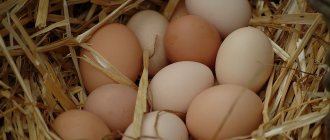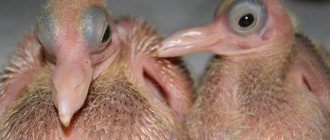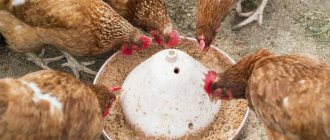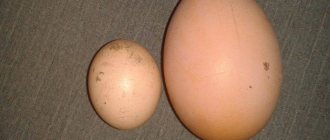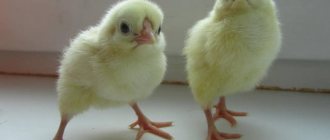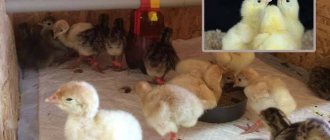The optimal time for slaughter of livestock depends on how long the broiler grows for meat. Receiving meat products in a short time depends on high-quality feeding and care of the poultry. Poor hygiene, lower temperatures and protein deficiencies will affect the health of broilers. And the farmer will receive an unprofitable business instead of profit. To increase production efficiency, it is recommended to use special tables and weigh chickens to adjust the diet.
Benefits of keeping broilers
Previously, there was no targeted selection of broiler chickens in order to obtain meat carcasses in a short period of time. But thanks to breeding work, multiline crosses have been developed that are adapted to cellular maintenance and the systemic delivery of compound feed.
The key to success is choosing a special cross. The benefit of backyard rearing is that the chickens gain 2.5 kg in weight before 6 weeks. After 50 days, hens reach 3 kg, and cockerels about 5 kg.
Study in detail the advantages of the chicken meat line in the article “Evaluation of broiler farming as a business: profitable or not.”
Meat yield at slaughter
When slaughtering birds, the following techniques are used:
- external: a 2 cm long incision is made with scissors at the bottom of the ear, bleeding the carcass takes 2 minutes;
- internal: the scissors are inserted into the chicken’s beak, and the vessels above the tongue are cut at the junction of the veins: the jugular and the pavement.
Important! Correct organization of broiler slaughter affects product quality and shelf life.
Plucking of the carcass is carried out in water, which is heated to +60…+70 °C. Complete processing manually. Half gutted on a special table.
The yield of chicken meat is determined by the ratio of the weight of chicken to the pre-slaughter weight of chicken as a percentage. For semi-gutted chicken carcasses, the yield of broiler meat from live weight is 81.8%.
On a note. Chicken meat is called fresh meat if immediately after slaughter the temperature in the thickness of the muscles is +25 ° C or higher. When the temperature varies from 0 to +4 °C, it is a refrigerated raw material. At a temperature of 8 °C we are talking about a frozen product.
In broilers, the slaughter weight is determined by the processing of the carcass: in uneviscerated chickens it is the highest, because it contains a mass of bloodless and plucked individuals with fat, paws, head, and in addition includes internal organs. The weight of a semi-gutted chicken includes the carcass with fat, but without the intestines.
If chickens are completely gutted, they get rid of:
- intestines and blood;
- down and feathers;
- head and internal organs;
- wing to the elbow joint and legs.
Interesting. The slaughter yield of a chicken carcass is 60%.
The growth of broiler breeds depends entirely on the diet and rearing conditions. When raising birds, certain periods are observed when the chickens gain weight. Broilers are distinguished by their efficiency in terms of the ratio of feed to live weight. Poultry farmers use specific nutritional plans to minimize the cost of purchasing feed and increase the growth of broiler meat on private farms. The correct menu, according to the recommendations, will allow you to enjoy chicken after 2 months.
Raising poultry of meat breeds is quite a profitable activity. Broiler chickens grow quickly, their dietary meat is tasty and is always in demand in the market. This picky bird willingly eats almost any food offered by the breeder. Broiler chickens raised for meat at home, choosing the optimal diet, growing period - all this can be learned from the article.
Broiler chickens have a high growth rate and within 8 weeks gain sufficient weight for slaughter
Popular broiler crosses
What is this
The term “broiler” does not mean a specific breed, but young meat crosses, specially fed to a marketable carcass.
More often, broilers are called hybrid lines from crossing Langshans, Plymouth Rocks, Cochins and other breeds.
Let's look at brief characteristics of common types.
Broiler-M
It is considered a universal cross. Hens fatten up to 2.8 kg, roosters about 3 kg.
After 5 months, chickens begin laying eggs, producing 160 eggs per year.
Broiler-61
Refers to a four-line cross. Plymouthrocks were used for crossing with Cochins. By 6 weeks after hatching, each chick has grown to 1.8 kg.
The advantages include high quality meat, rapid weight gain, and survival rate compared to other broilers.
But building up mass becomes the scourge of cross-country training - problems with bones begin. Therefore, it is advised to adjust the diet of young animals.
ROSS-308
With proper fattening, broiler chickens gain 2.5 kg up to 6 weeks of age.
During the day, the young animals become 55 g heavier, which is considered an indicator of a properly formulated diet.
ROSS-708
They are characterized by rapid weight gain. Already after the first month of life, they grow about 2.5 kg.
The only drawback is that buyers do not really like the whitish skin, which is explained by the rapid growth of chickens.
Gibro-6
Young broilers gain 30 g of weight every day, which translates to 1.5 kg of broilers at 1.5 months.
The bird is covered with white plumage and shows sufficient egg production - 160 eggs. A commercial quality carcass with yellow skin is obtained. But when growing, they monitor the diet because of the fragility of the bones.
COBB-500
It is recommended to feed intensively in the first month of life. The advantages are considered to be insignificant expenses on feed and sufficient survival of young animals.
Chickens in a flock develop equally. An increase of up to 2.5 kg is obtained within 40 days.
Change
A highly productive cross, giving an increase of up to 40 g per day. About 140 eggs are obtained from laying hens during the egg-laying period.
The young are considered resilient. Although it is recommended to keep the livestock after hatching in a warm poultry house with additional heating.
conclusions
The carcass with the yellowish skin of the COBB-500 cross is considered the most attractive for sale. It is obtained without adding corn grain or food additives to the diet of young animals.
Read the detailed description of KOBB-500 and other popular broilers in the article “About broiler chickens: what they are and which ones are better.”
Raising broilers for meat is available to every farmer. Of course, if you know how long a chicken grows to reach its optimal weight.
During the first 20 days, chickens produce maximum growth. Over the next 3 weeks, the diet, temperature and hygiene of the poultry house are monitored to further increase the weight of the chickens before slaughter.
After broilers reach 3 months, their maintenance becomes impractical due to growth inhibition and increasing feed costs.
How to properly pluck a carcass
The quality of the meat directly depends on whether the bird was plucked correctly. If feathers and fluff remain on the carcass, you will have to process it longer and more intensively over a fire or remove excess with tweezers, which will immediately affect the color of the skin and, accordingly, will make the product unattractive to the buyer (if the bird is slaughtered for sale).
Plucking is preceded by scalding the chicken in hot water. The plucking procedure itself is carried out manually, or the farmer can use special tools to remove feathers. When manually removed, the feathers are simply carefully pulled out. At the same time, they try to act gently (do not make sudden movements) so as not to damage the skin. When damaged, it turns blue and becomes brittle.
Scalding a carcass
There are 2 methods of scalding - soft and hard. With a gentle scalding method, it is not possible to remove all feathers 100%, but, which is important in the case of poultry, it is possible to preserve the yellow color of the skin. The time and water temperature depend on the age and type of bird.
So, an adult chicken is placed in water heated to 53 degrees Celsius for about 4-4.5 minutes. Broilers are scalded during the same time, but in water whose temperature reaches 58 degrees Celsius. To scald chickens (soft method), they need to be kept in water heated to 52 degrees Celsius for 3-3.5 minutes.
During hard scalding, the feathers are completely removed (this is possible due to the increase in water temperature), the skin of the bird is treated with a feather removal machine, removing yellowness. The carcass becomes shiny and white.
Removing litter
To remove droppings:
- a paper swab is placed in the oral cavity;
- press on the bird's belly and wait for the last excrement to come out.
In this case, it is better to cover the legs and hips with a plastic bag, thus protecting them from droppings.
Gutting a bird
After removing excrement and scorching, gutting begins. This process has already been described above, but it should be mentioned once again how important it is to take care of the safety of the intestines and gall bladder during the evisceration process. In some cases, it is better to first remove the gall bladder and then free the carcass from droppings.
Change in weight of broiler chickens with age
Up to 10 days
The secret to growing massive birds is considered to be the skill of the poultry farmer. Particular attention is paid to caring for young animals in the first month of life.
The weight of the hatched chick is about 50 g, with deviations of 1-2 g. The first weighing provides the prerequisites for determining which broilers will gain more weight in the future. Even an excess of 2 g in a chicken will allow one to judge the growth of a large marketable carcass.
Feeding with prestarter feed makes it possible for each bird to gain up to 200 g in the first ten days. This approach has a beneficial effect on the digestive tract, absorption of nutrients and building muscle mass.
Regular food is not able to saturate the body with the necessary components, and the farmer will not be able to raise a large meat chicken.
After 10 days
From ten days of age, young animals are transferred to adult poultry feed in order to save money on feeding. By 14 days, the weight of each chicken should reach 0.5 kg. After which the livestock gains weight more slowly.
The average weight of a month-old broiler is up to 1.5 kg. But in this case, the mass of the bird depends on its belonging to the cross.
Poultry farmers prepare chickens before slaughter, obtaining tender meat with high taste values, valued on the market. Although up to 2 months the young animals reach only 3 kg, further maintenance becomes unprofitable.
Chicken cutting procedure
After bleeding, all feathers are removed from the carcass (plucked), and then it is gutted and cut up. Before cutting, the carcass is cooled in cold water for 10 minutes. This avoids filling the capillaries with blood and causing an unpleasant bluish tint. Carcass:
- placed on the stomach;
- make an incision at the anus and remove the entrails as described above (start with removing the offal);
- The trachea and esophagus are removed through an incision in the neck;
- an incision in the larynx helps remove the goiter with food debris.
After removing the entrails, the carcass is washed and dried. The described cutting method is classic.
No waste
The waste-free cutting method works like this:
- the carcass is placed on its back and the legs are separated, cutting the place where they join the body and sharply turning them out of the joint;
- separate the wings by pulling them to the side and cutting along the shoulder joint;
- an incision is made along the spine and chest, dividing the body into 2 parts;
- separate the breast from the back;
- the resulting halves are cut in half.
Pieces of meat are stored in the freezer or used to prepare any dish.
For portioned pieces
After dividing the carcass, you should get exactly 8 portions. For this:
- the bird is placed on its back and, using a sharp knife, the thighs are separated;
- the resulting pieces are divided into 2 parts, so that you get 2 drumsticks and 2 thighs;
- separate the wings from the carcass;
- placing the carcass on its side, separate the breast from the back (under the breast there is a layer of fat on each side, which needs to be cut, moving from bottom to top);
- the breast is divided into portions; to do this, it is cut in half along the bone into 2 equal parts;
- The fillet is separated from the ribs and the skin is removed.
Portioned pieces are used to prepare salads and roasts; the back is boiled, producing a delicious broth.
Ready-made portion cutting
This type of cutting of a chicken carcass is practiced after it has been boiled or baked, and in its entirety. The process is similar to cutting a fresh carcass into portions. They also begin by separating the legs and thighs from the body of the bird, and then the wings. The flesh is separated from the bone by making an incision along the sides of the breast. The resulting pulp is divided into several portions.
Raw Processing
Processing chicken raw is actually dividing it into portions or simply gutting it. It all depends on the goals being pursued. If the bird is going to be sold on the market, I limit myself to removing the entrails, knives and head. But if the meat is planned to be used immediately, the carcass is still divided into separate pieces.
Control weighing of young animals
It is important
To determine how long broilers grow before reaching the desired weight for slaughter, it is recommended to weigh them periodically.
To help farmers, a special table has been developed indicating the growth of broiler chickens by day, presented in the article “How much does a chicken weigh on average?”
All that remains is to start weighing. And here it is recommended to use scales or a canter. Meat chickens have a phlegmatic character, so even a beginner will not have a problem finding out their weight.
Weighing techniques
Using scales. It is advisable to have a bag with a lid on hand. First, place the bag on the scales and remember the weight. It is advisable to carefully place the broiler in the weighing bag. It remains to subtract the weight of the empty bag from the resulting value to find out the mass of the bird. The technique is used for large individuals.
Using a canter. Place the broiler in a thick gauze bag. Make sure that it does not accidentally burst under its weight. Hang the bag to the canter, slowly lift it, and look at the indicators.
Deviations in weight to a lesser extent become a reason to revise the diet of young animals.
The procedure of weighing chicken only at first seems difficult, but later it will help to raise productive livestock with large weights. And there will no longer be any confusion about how long chickens grow before slaughter.
Causes of inhibition in development
General
If purebred chickens are immune to most diseases, then meat crosses are demanding in terms of housing conditions and a special diet.
Beginning poultry farmers are often faced with the problem of broilers lagging behind in development, diseases and mortality.
It is necessary to dwell in detail on the mistakes that lead to the disappointment of farmers and the refusal to raise broilers.
Weight Loss Factors
A specific line of crosses. Among the many meat lines, varieties with fast and slow weight gain have been bred. Perhaps the poultry farmer purchased a cross that grows slowly, but later gains weight.
Dietary disorder. Meat chickens need increased amounts of protein in their feed. And without amino acids they will not build muscle mass.
Dysfunction of the gastrointestinal system. Immediately after birth, young animals need to be fed with special feed. If the conditions are not met, dispersion develops. Another cause of frustration is the distribution of moldy food.
Large walking area. Broilers are bred to be kept in cages, and walking does not promote weight gain. It is recommended to transfer the livestock to cramped conditions at the rate of about 0.5 m2 of area per 10 chickens.
Other circumstances
Keeping at low temperatures. Cold becomes another reason for weight loss in young animals, who spend energy on heating the body.
Gas pollution in the room. Lack of ventilation leads to poisoning of livestock and reduces weight gain.
Diseases and parasites. If chickens are rapidly losing weight, there is a reason to examine the flock for helminth infection.
In order to prevent diseases, it is recommended to regularly feed young animals with vitamins and a slightly pink solution of potassium permanganate.
It is common practice in poultry farms to feed broilers antibiotics and growth stimulants. The livestock quickly gains weight and is not susceptible to disease.
In order to grow a healthy herd, common mistakes are eliminated.
The basic “commandments” of a poultry farmer
In order for the business to be profitable and you to receive a lot of eggs throughout the year, you need to remember the basic rules of a successful poultry farmer:
- You can't overfeed chickens. Well-fed “balls” will not please you with good egg production; on the contrary, they will often get sick, walk sluggish and lazy. And who benefits from obesity anyway?
- Provide a “quiet hour” for chickens from 8 am to 4 pm and do not disturb them unnecessarily - they are busy with important work. If you make a lot of noise and disturb the intimate atmosphere, the chicken will not lay an egg that day.
- Provide
Tips for gaining weight
Content adjustment:
- Equipment for an insulated poultry house. The herd is kept on a thick layer of bedding or in cages. It is highly undesirable to equip a walking yard where the bird feels uncomfortable.
- Remove damp bedding regularly to prevent mold from growing on the floor. High humidity causes indigestion.
- The air temperature during the first week of chickens’ life should not fall below +30°C. As the livestock matures, the indicators are reduced to +20°C.
- The lights in the room are never turned off. It is advisable to use dim light and paint the lamps red to avoid outbreaks of cannibalism.
- The poultry house is promptly cleared of excrement and internal surfaces and equipment are disinfected.
- The bird is sensitive to ammonia fumes, so ventilation or vents are installed to ventilate toxic substances.
- Place basins with an ash-sand mixture for bathing chickens. This is how they get rid of parasites on their own.
If the housing conditions are met, and the chickens look sick, it is advisable to introduce food additives into the diet. For example, Chiktonik, the use of which is described in the article “Instructions for using Chiktonik for chickens.”
Lighting and air temperature when raising chickens
During the first weeks of life, most chicks experience discomfort from hypothermia or high temperatures. After all, until the age of one month, the body of “babies” cannot effectively adapt to changes in the external environment in the shortest possible time. Therefore, the poultry farmer is obliged to monitor humidity and temperature indicators. In a cool room, you need to install additional heating devices, and the hot room should be constantly ventilated. Therefore, the conditions for raising chickens must necessarily include careful control over the temperature in the chicken coop:
- For the first 24 hours, the bird's offspring must exist in the same conditions as they had in the incubator, at a temperature of 35 degrees (not lower);
- Then this indicator is systematically reduced to 30-32 degrees - in the first seven days from the moment small pets are born;
- From the 2nd week, temperature marks gradually continue to decrease so that by the age of one month the bird can live calmly at a temperature of 21 degrees;
Important: young animals need heating not only during the day, but also at night, as well as on cloudy days and during cold seasons.
Provide round-the-clock lighting for the chicken coop (especially in winter) using artificial incandescent lamps.
- The first few days the lamps are on constantly and do not turn off. This makes the chicks move more actively, grow and feed.
- Next, the lights are turned off for 15 minutes, then 30, accustoming the “birds” to the dark.
- When the young animals turn 4 months old, daylight hours are shortened to ten hours.
The light is set at a height of 45-50 cm, and the microclimate is controlled by installing a thermometer. If the inhabitants of the poultry house are crowded under the lamp or pressed against each other, they are obviously freezing. And the heat can make their wings and feathers ruffle and move little.
The relationship between nutrition and weight gain
Advice
Crosses are specially created for producing marketable meat carcasses. And in order for broilers to grow quickly, they provide the livestock with complete feed, proteins, vitamins and microelements.
It is recommended to use a scheme for raising young animals, which includes four fattening periods.
First
The pre-launch period falls on the first week of broiler life. Feed is given 8 times a day, at the rate of 20 g of food for each chicken.
In addition to pre-start feed, chopped boiled eggs, oatmeal, and low-fat cottage cheese are fed. Weight gain per day is at least 15 g. At the end of the first stage, the weight of the chickens is about 115 g.
Second
The starting period starts from 6 to 20 days. Reduce the number of feedings to 5 per day. But they increase the portion from 50 to 80 g per chicken.
Weighing shows a weight gain of at least 30 g per day. By the end of the period, young animals weighing 650 g are obtained.
It is allowed to feed ad libitum, bringing the amount of corn to 45% of the total feed. The young animals are given grated carrots and pumpkin, greens, bone, fish and grass meal, yeast, meal, and animal fat.
Third
The fattening stage lasts up to 40 days. With proper feeding, the bird gains about 55 g per day. Therefore, chickens at the final stage weigh 2.1 kg.
Each bird is given 150 g of feed 4 times a day, feeding the young with boiled potatoes, fish, yeast, grain crops, chalk and premixes.
Fourth
At the final stage before slaughter, each broiler is given 170 g of feed twice a day. They provide food in abundance, switching the livestock to whole grains, green mass and succulent feed. Feeding allows you to get carcasses of 2.5 kg.
To gain weight, it is recommended to ensure the supply of microelements and minerals, and not to skimp on high-quality feed and vitamin supplements.
Detailed recommendations for preparing a diet are described in the article “Feeding standards for broilers.”
Profitability of laying hens
Breeding laying hens is a profitable business. In 10 days you can get a dozen eggs at the rate of one per day. Given a large number of individuals, this very quickly pays for both the expensive food and the purchase of chickens.
Read also: Why apricot does not bloom, what to do
Important! The number of eggs laid is directly proportional to the amount of vitamins the birds receive and the quality of the conditions.
Chickens should be kept in a dry, warm room, fed with special mixtures or grain with added vitamins. However, no additives can replace the complex of nutrients that birds can get by consuming regular grass. Many poultry farmers complain that with the onset of the cold season, chickens stop laying eggs. You can maintain egg production rates by paying attention to the maintenance and diet of laying hens.
Benefits of feeding with compound feed
Meat crosses quickly gain weight in a short time. Therefore, you should provide them with a high-calorie diet rich in vitamins and nutrients for development.
Without the provision of complete, balanced feed, it is not possible to obtain marketable carcasses in a short time.
More often, farmers purchase ready-made combined mixtures in production. But it’s cheaper to make your own feed, using the advice from the article “Types and composition of feed for broilers.”
Dry food or mash
To ensure good weight gain in chicks, it is important to feed them both dry feed and mash. Granular food is chosen as a dry mixture.
The mash consists of milk, feed and whey. Meat broth is also used. For every kilogram of dry food, chickens are given 500 ml of liquid. The mash quickly turns sour. This needs to be monitored: an hour after eating, all feeders are cleaned.
Alternating dry food and mash is the best option. The first one should always be in the feeders.
Meat crosses quickly gain weight in a short time. Therefore, you should provide them with a high-calorie diet rich in vitamins and nutrients for development.
Without the provision of complete, balanced feed, it is not possible to obtain marketable carcasses in a short time.
More often, farmers purchase ready-made combined mixtures in production. But it’s cheaper to make your own feed, using the advice from the article “Types and composition of feed for broilers.”
It is important for poultry farmers to know how much feed they need to raise a broiler at home.
Feed consumption by age and estimated live weight gain
| Chick age | 1 day – 2 weeks | 2 weeks –1 month | 1–1.5 months |
| Feed consumption (g) | 15-80 | 80-120 | 120-180 |
| Average weight | 40 g-0.5 kg | 0.5-1.6 kg | 1.6-2.5 kg |
| Average growth (years) | 30 | 48 | 55 |
Broiler fattening follows a certain structure. In order for chickens to gain weight rapidly, it is necessary to ensure regular feeding and watering, according to the scheme: prestart - start - fattening - finish.
On a note. The proportion of water and feed in the birds’ diet is 1.7:1.
For the effectiveness of the diet, it is important to remember the age of the bird. To understand how much feed a broiler eats before slaughter, you will need a table. It shows the number of chickens per day. The table allows you to control the standards for the successful rearing of birds.
Feeding broiler chickens
Within 5 days, the chicks consume 15 g of feed. After 5 days, the dosage is increased to 20 g. Starting from day 11 to 20, 45 g of feed is consumed daily. Then every 2 weeks the amount of feed increases by 20 g. A one-month-old chick eats 120 g.
The nutrition table and visual information will make it easier to calculate your diet.
Amount of feed, depending on the age of the chicks
| Age, days | Feed, Mr. |
| 01.05.2018 | 15 |
| 06.10.2018 | 20 |
| 01.11.2020 | 80 |
| 21-30 | 120 |
| 31-45 | 180 |
| 46-60 | 220 |
You will need to feed the chicks frequently for the first 5 days. Chickens eat food 8 times daily, but in small doses. Young animals have a poorly developed digestive system: they do not digest food in large quantities.
After a week, the chickens are transferred to five feedings a day. At the age of 1 month and until the broilers are slaughtered, fattening twice a day is suitable.
Attention! Eating feed determines how long a broiler grows at home before slaughter. The intensity of fattening young animals is determined by the age of the chickens. They focus on slaughter feed for broilers at the final stage of rearing.
Broiler diet
Chickens need a balanced diet. To gain weight, mash is used, as well as dry food in granules.
The mash contains whey or milk, as well as mixed feed. Meat broth is good. 0.5 liters of water is given per 1000 g of dry chicken feed. The product sours quickly. An hour after feeding, remove any leftover food and wash the dishes.
The feed contains the following ingredients:
- oats and wheat;
- fishmeal and corn;
- table salt and barley;
- cake
The age of the bird affects the set of components.
Chicks have an acute reaction to a deficiency of vitamins in food. Broilers systematically need special vitamin supplements.
Vitamins A and E appear on the menu on the 5th day. This is followed by the addition of ergocalciferol. The following ratio is followed: for 10 ml of D2 0.5 l of vegetable oil. Storing the mixture in the refrigerator. Feed the chicks 2 times a week, adding 1 tsp. drug per 1000 g of feed.
Grass feeding
Green crops and grass are constituent elements in bird food. Responsible for providing chickens with vitamins. A special mixture, which includes microelements and grain, can be found in the retail chain. Adult broilers are separated so that the chickens cannot be eaten.
Attention! Broilers are not fed greens immediately after hatching.
It is advisable to mow the grass before feeding. Flour from oats and barley along with curdled milk is mixed into the greens.
Chopped grass is fed to the birds from the 5th day, 3 g are spent on the broiler daily. After a couple of days, the standard increases to 5 g, but no more.
Crushed greens in a volume of 7 g are given to chickens from 11 to 20 days. On day 21 it is increased to 10 g. The increase to 17 g occurs on days 41-50.
Greens that benefit chickens:
- sorrel and radish foliage;
- plantain and onion feather;
- peas and chickweed;
- dandelions and lettuce;
- quinoa and garlic stalks.
Herbs containing many useful substances are required for the growth of broilers. Plants are selected carefully for fear of poisoning the chickens.
Greens for chickens
Toxic plants:
- burdock and potato flowers, foliage;
- white acacia and tomato branches;
- horse chestnut and elderberry;
- juniper, leaves and pear seeds.
On a note. Knowledge of herbs will allow private owners to avoid risks when feeding and not worry about reducing the growth parameters of meat chicken breeds.
At home, you can also get decent results if you know what and how to feed broilers. If everything is done correctly, birds raised on your farm will be no worse than those purchased in a store.
Feeding broiler chickens kept at home differs from that used in industrial poultry farms. On them, chickens are fed with compound feed or special various grain mixtures, but at home, the diet of birds can be made more varied. In addition to feed, chickens can be fed vegetables and herbs, and mash and grain mixtures from various ingredients can be prepared for them.
If you choose products that are balanced in terms of nutrients, vitamins and minerals, and energy value, then you can create your own proper diet and at the same time save on feed, which is not always of good quality.
Broiler feeding has the following features:
- chickens should have free access to clean and fresh water at a comfortable temperature;
- stable temperature and a certain length of daylight hours. The optimal temperature in the poultry house for broiler chickens aged 1–7 days should be 32–35 °C, at 2–3 weeks – 24–29 °C, over 3 weeks – 20–24 °C;
- Feeding should be periodic, food should be distributed after a certain period of time. This is consistent with their physical characteristics: food passes through the chicken’s gastrointestinal tract in 2–3 hours, after which it begins to feel slightly hungry;
- when using bunker and groove feeders, 1 head should have at least 2 and 3 cm, respectively;
- To ensure that broiler chickens do not have gastrointestinal diseases, they are given a pale pink solution of potassium permanganate 2 times a week.
During fattening, the birds' physical activity is limited, they are kept only in the chicken coop, without walking, so that they do not waste energy on movement, but only gain the required weight.
Frequency of feeding
Feeding of domestic broiler chickens should be carried out according to a schedule. The entire daily amount of feed should be divided into parts and fed at certain intervals. The frequency of food distribution for different broiler crosses is practically the same, but, in general, it looks like this:
- the first 10 days - every 2 hours and 1 time at night;
- from 11 to 30 days - the number of feedings is reduced to 6 times, but the volume of food given at a time is increased: 6:00 - crushed grain; 9:00 – wet mash with chopped herbs and mashed boiled potatoes; 12:00 – dry crushed grain mixture; 15:00 and 18:00 – wet mash; 21:00 – grain (crushed);
- from 31 to 45 days - food is distributed 4-5 times a day.
We invite you to familiarize yourself with a fence made of plants at the dacha
Broilers are slaughtered at the age of 45 days (if they are kept in cages), and when kept on floors, they can be reared for a maximum of 9 weeks; keeping them longer becomes economically unprofitable.
Feeding ration
The simplest feeding scheme for broilers, which is suitable for novice poultry farmers, involves feeding them with ready-made mixed feed: up to 30 days - starting feed, from a month until slaughter - finishing feed. The protein level in the starting stage of feeding should be 23%, in the finishing stage it should be less - 21%.
A slightly more complex scheme is feeding with 3 types of compound feed: up to 3 weeks of age - starter compound feed, the next 2 weeks - growth feed, from 35 onwards - finishing feed. With 3-period feeding at the start, the level of crude protein in the chicks’ diet should be 23%, during the growth period - 21% and in the finishing period, respectively, 20%.
But it is best to feed broilers at home for rapid growth and weight gain according to a four-stage scheme that most fully meets the needs of meat cross chickens. In this case, the feed for broiler chickens will be mixed feed of different types.
From 0 to 5 days
This stage is the most important in fattening broilers for meat in the household. Chicks that have recently hatched from the egg must have their digestive system adjusted, so they must be given special mixtures designed for chicks of this age.
To feed broiler chickens, pre-start feed (PK-5) is used, adding a little skimmed milk powder or milk, also dry in an amount of 3–5% (thanks to these additives, the broilers’ need for all essential amino acids is satisfied).
In this feed, all nutrients are in high concentration, are highly soluble in water and are easily processed in the digestive tract of chickens. It contains cereals with a high content of simple carbohydrates and sucrose, and soybean meal.
The particle size of this mixture is very small - it looks like finely crushed chaff or flour.
Components Quantity, %
| finely ground corn | 40 |
| finely milled wheat | 40 |
| soybean meal or sunflower cake | 10 |
| dry return | 10 |
Until 4 weeks of age, grain feed (barley, millet, oats), as well as sunflower cake and meal, must be sieved to separate from the films, as they can clog the muscular part of the stomach of chickens and cause their death.
From 5 to 18 days
How long do they grow before slaughter?
It is not advisable to keep broiler chickens for more than 3 months. The livestock stops gaining weight by consuming large amounts of feed.
Find out the exact volumes of feed in the article “How much feed does a broiler need before slaughter.”
The farmer will face unjustified costs due to a decrease in the quality of meat. Broilers become overgrown with fat, the meat becomes fibrous and tough.



